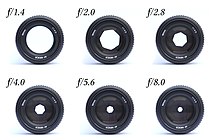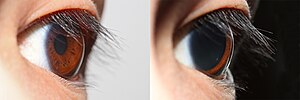An aperture creates the opening through which light travels in an optical system. This hole or opening controls how much light reaches the image plane, similar to how your eye’s pupil adjusts to different lighting conditions.
System Components
The aperture stop serves as the primary limiting factor for light rays entering the system. This critical component determines:
- The cone angle of incoming light
- The brightness at the image point
- The depth of field in the final image
Practical Applications
In photography and astronomy, aperture refers to the diameter of the opening. A telescope might have a 100-centimeter aperture, while a camera lens expresses aperture as an f-number ratio between the focal length and effective aperture diameter.
Maximum Apertures
Fast lenses offer wide maximum apertures of f/2.8 or larger. The fastest production lenses reach f/1.2 or f/1.4, with some specialized optics achieving f/0.95. Stanley Kubrick used an exceptional f/0.7 lens to film candlelit scenes in Barry Lyndon.
Minimum Apertures
Most DSLR lenses stop down to f/16 or f/22. Large format cameras can reach f/64, while macro photography sometimes requires even smaller apertures like f/96 for extreme depth of field.
Performance Effects
The aperture size influences several key factors:
- Light admission control
- Depth of field adjustment
- Optical aberration management
- Image vignetting prevention
- System telecentricity
Your choice of aperture creates a balance between light gathering ability and image quality. Smaller apertures increase depth of field but can introduce diffraction effects, while larger apertures allow faster shutter speeds but may show lens aberrations.
Citations:
https://en.wikipedia.org/wiki/Aperture
In optics, the aperture of an optical system (including a system consisted of a single lens) is a hole or an opening that primarily limits light propagated through the system. More specifically, the entrance pupil as the front side image of the aperture and focal length of an optical system determine the cone angle of a bundle of rays that comes to a focus in the image plane.





An optical system typically has many openings or structures that limit ray bundles (ray bundles are also known as pencils of light). These structures may be the edge of a lens or mirror, or a ring or other fixture that holds an optical element in place or may be a special element such as a diaphragm placed in the optical path to limit the light admitted by the system. In general, these structures are called stops, and the aperture stop is the stop that primarily determines the cone of rays that an optical system accepts (see entrance pupil). As a result, it also determines the ray cone angle and brightness at the image point (see exit pupil). The aperture stop generally depends on the object point location; on-axis object points at different object planes may have different aperture stops, and even object points at different lateral locations at the same object plane may have different aperture stops (vignetted). In practice, many object systems are designed to have a single aperture stop at designed working distance and field of view.
In some contexts, especially in photography and astronomy, aperture refers to the opening diameter of the aperture stop through which light can pass. For example, in a telescope, the aperture stop is typically the edges of the objective lens or mirror (or of the mount that holds it). One then speaks of a telescope as having, for example, a 100-centimetre (39 in) aperture. The aperture stop is not necessarily the smallest stop in the system. Magnification and demagnification by lenses and other elements can cause a relatively large stop to be the aperture stop for the system. In astrophotography, the aperture may be given as a linear measure (for example, in inches or millimetres) or as the dimensionless ratio between that measure and the focal length. In other photography, it is usually given as a ratio.
A usual expectation is that the term aperture refers to the opening of the aperture stop, but in reality, the term aperture and the aperture stop are mixed in use. Sometimes even stops that are not the aperture stop of an optical system are also called apertures. Contexts need to clarify these terms.
The word aperture is also used in other contexts to indicate a system which blocks off light outside a certain region. In astronomy, for example, a photometric aperture around a star usually corresponds to a circular window around the image of a star within which the light intensity is assumed.
English
Etymology
From late Middle English, from Latin apertūra (“an opening”), from
...
